Stars: Mark Hamill, Harrison Ford, Carrie Fisher, Billy Dee Williams and Anthony Daniels
 |
This is the fifth entry in my Star Wars I-VII Runthrough, which aims to look at the entire series of feature films with three things in mind: quality, progression and the fan theory of Jar Jar Binks as ultimate villain. Hello, Star Wars: Episode VI - Return of the Jedi!
 |
Brief Synopsis
A year after The Empire Strikes Back, the Galactic Empire is building a new Death Star, bigger and more powerful. The Rebel Alliance aims to destroy it before it becomes operational. One group plans to take down its shield generator on the moon of Endor so the main fleet can attack the space station. But are the Empire in on the plan?
The primary players are Luke Skywalker, now a Jedi knight; Han Solo and Lando Calrissian, who both become generals in the Rebel Alliance; Princess Leia, who is revealed as Luke's sister; and the Emperor and his right hand man, Darth Vader, Luke and Leia's father. Other characters from earlier films continue in small roles, led by the droids, C-3PO and R2-D2.
Quality
If you listen to most Star Wars fans, it's almost a mantra that the prequel trilogy is notably worse than the original one. As was hardly surprising, I was warned against watching them this week. Just watch the originals, I was told! A much more niche viewpoint, but one that was also expressed to me this week in a Facebook comment, is that the very worst film in the series is not The Phantom Menace but Return of the Jedi. I have to say, having just watched the first six episodes in six days, that I can understand both those viewpoints.
That comment resonated with me as I watched Episode VI, the last of the original trilogy, because it's immediately weaker on the effects front and, once it settles down, starts to fall apart on the story front too. It took me a while to realise exactly what was going wrong, but eventually I came to a few realisations.
For one, very little actually happens in the original trilogy at the grand scale, events of galactic importance being reserved mostly for the prequels. Just think about it.
In The Phantom Menace, democracy fails as the Trade Federation challenges the Galactic Republic and armed conflicts begin. In Attack of the Clones, thousands of solar systems leave the Republic, full scale war erupts and emergency powers are declared. In Revenge of the Sith, the Jedi, who have kept the peace for a thousand years, are destroyed or driven into exile as the Sith take over and form the Galactic Empire.
That's a lot of important stuff going on in the prequels! Now what about the original trilogy?
Well, in A New Hope, the Death Star finally comes online after an entire generation of construction and it blows up one planet before being destroyed itself, but nothing else changes. In The Empire Strikes Back, the only thing of note from a galactic perspective is that the Empire discovers the new rebel base. Here, the new Death Star is destroyed and the Emperor killed.
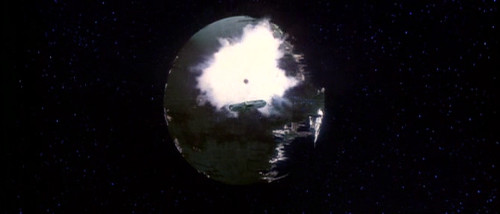 |
It's not space opera, it's soap opera, because what we care about are the charismatic rebels to whom we've become endeared over three movies, but I wonder if we realise that most of what they get up to here isn't what they should be doing. The rebels are about to launch an attack on the Empire's new and improved Death Star because, as the opening text crawl points out, they face certain doom if they don't. So where are these important players, such as Luke Skywalker, the only jedi they have left; Leia, princess and former galactic senator; or Lando Calrissian, now a general in the alliance? Well, they've wandered off for a bit. They're on Tatooine, risking their lives to rescue Han Solo, who's sitting on Jabba the Hutt's wall encased in carbonite. Would anyone call this the best use of these resources? I don't think so.
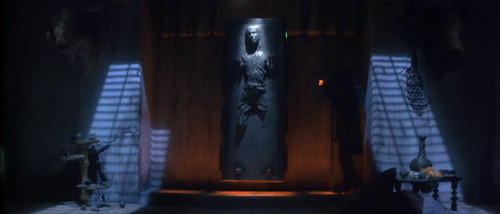 |
What carries meaning to us in this film is incidental to the grand story, which really doesn't help the series at all. We spend three films notching off milestone after milestone in a vast space opera, then three more meandering their way to just one last milestone that is more symbolic than really impactful. It's the next film, Episode VII, that is going to be important because it's when the Empire can truly fall. It merely lost its leader here.
And, as the title of that eventual film points out, it's when The Force Awakens. The title of this film has far less meaning. Return of the Jedi? Well, the one we've been following for two movies is still around, but that's about it. We start the film with two jedi and end it with one; that's not much of a return. It's going to fall to the next film for that.
So, with so much missing, what do we actually have here in what was the most recent film in the Star Wars chronology for over thirty years?
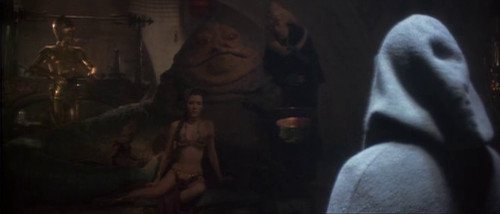 |
These early scenes are a lot of fun and would be more so if the effects work wasn't so awful. I didn't see greenscreen issues in The Empire Strikes Back, but they're everywhere here. Otherwise well constructed scenes, such as the Sarlacc pit on Tatooine and the speeder bike chase on Endor are hamstrung by poor greenscreen work. The choreography is awful too, with everyone's shooting above the Sarlacc pit worse than stormtrooper bad and Luke's lightsaber managing to kill a whole heck of a lot of people that it doesn't even get close to.
This is especially odd given how many awards the effects crew were hauling in at the time, but then other aspects are handled well. The explosions are awesome, much better than the previous two movies. The machinery in play is suitably diverse, with a host of great modelmaking on show for ships, speeder bikes and AT-STs, those walkers that fight on Endor. The aliens are also suitably diverse, from Admiral Ackbar and Jabba the Hutt to those furry little Ewoks. Many of these were created using puppetry, which I admire immensely.
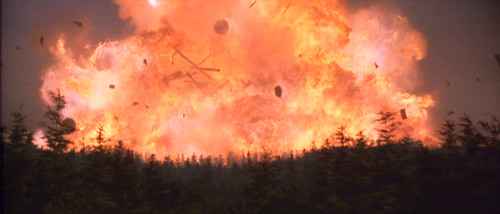 |
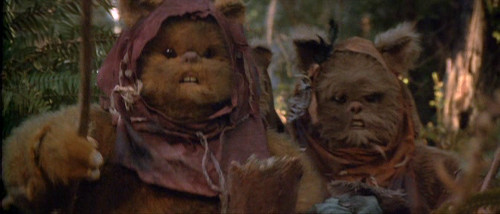 |
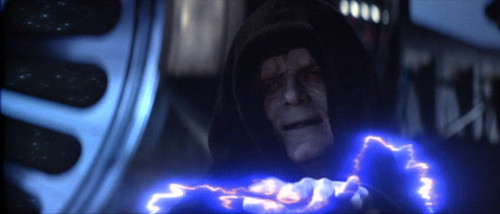 |
Progression
With so much attention on our favourite characters, there ought to be a lot less problems with continuity, but I caught a bunch of stuff that played very wrong, though most of it is apparent only in the context that the prequels provide.
For a start, there's the new Death Star. The original took an entire generation to build, having been started in Revenge of the Sith but not activated until A New Hope. However, somehow the replacement gets operational in the four ensuing years but the people responsible are still castigated for taking too long! Cut them a break, Vader!
 |
However, a number of problems leap out after the prequels were added. Leia remembers her real mother, even though she saw her for perhaps two minutes. Obi-Wan says he chose to train Anakin, though that choice was later shifted over to Qui-Gon Jinn in The Phantom Menace. Vader also seems to be unwillingly subservient to the Emperor here, turning to the dark side not to achieve anything but simply because he was too weak to resist. Beyond inconsistency with the prequels, that's a really odd decision to make for the character who had been the face of evil for two of the biggest movies ever made.
One other odd decision was to summarily kill off Yoda for no apparent reason or gain. He's a sprightly 800 year old in The Empire Strikes Back, able to lift Luke's X-Wing from a swamp using only the power of the force. Here, a single year later, he's a doddering wreck who's now 900 years old and leaves the series in a cheaply written scene.
And how did Luke become a Jedi knight anyway? He was supposed to go back to finish his training under Yoda, but doesn't until it's too late. Yet, without another jedi in the whole universe, let alone a Jedi Council, he suddenly gets promoted! How did that happen?
Jar Jar Binks
Of course, Jar Jar isn't here but the Emperor's choice to visit the new Death Star might only make sense from the perspective of his master remaining at the centre of power back on Coruscant. I'm waiting for him to rise as Darth Tragus in the new sequel trilogy.
It's well known that Lucas played with patterns in these movies. Each trilogy follows a similar trajectory but in mirror form. If the prequels followed the rise, fall, rise of the Empire and the originals followed the rise, fall, rise of the rebellion, then the sequel trilogy ought to be a fresh rise, fall, rise for the Empire, leaving the bad guys back in charge after Episode IX.
At this point, between Episodes VI and VII, Supreme Chancellor Palpatine aka the Emperor is dead and his succeeding right hand men are dead too: Count Dooku and Anakin Skywalker aka Darth Vader. Who's left of any note in the Empire's ranks? We've never really been privy to more than a few admirals and generals, who Vader always force chokes to death when they fail him.
The most logical explanation is that the real Phantom Menace hinted at in Episode I is still hiding in the shadows and will soon return to prominence to fill the void created by the death of the Emperor. Who else could that be but Jar Jar Binks?


No comments:
Post a Comment